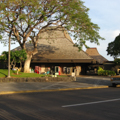The Keahole airport is a complex of single-story pavilions whose double-pitched, truncated hipped roofs shelter check-in, baggage claim, and gate activities. The airport's open, free-flowing space exudes a spirit of Hawaii, one which has been mitigated by recent federal security requirements. Here passengers check in and await their flights or baggage in a fresh-air environment, with the blues skies and coconut palms towering over them. This villagelike complex handled almost three million passengers in 2005.
Honolulu architects Ed Aotani and Shizuo Oka were classmates at the University of Oklahoma, where they studied architecture under Bruce Goff. Upon graduation Aotani entered the military and Oka studied in Japan. In 1958, Aotani opened an office in Honolulu, and in 1967, the partnership of Aotani and Oka was formed. The firm designed a number of condominiums and the Maui County Courthouse (2145 Main Street) in Wailuku. Later, Aotani and Associates was involved in the Aloha Tower Market Place (OA37) and the planning and design of Sand Island Park in Honolulu.









